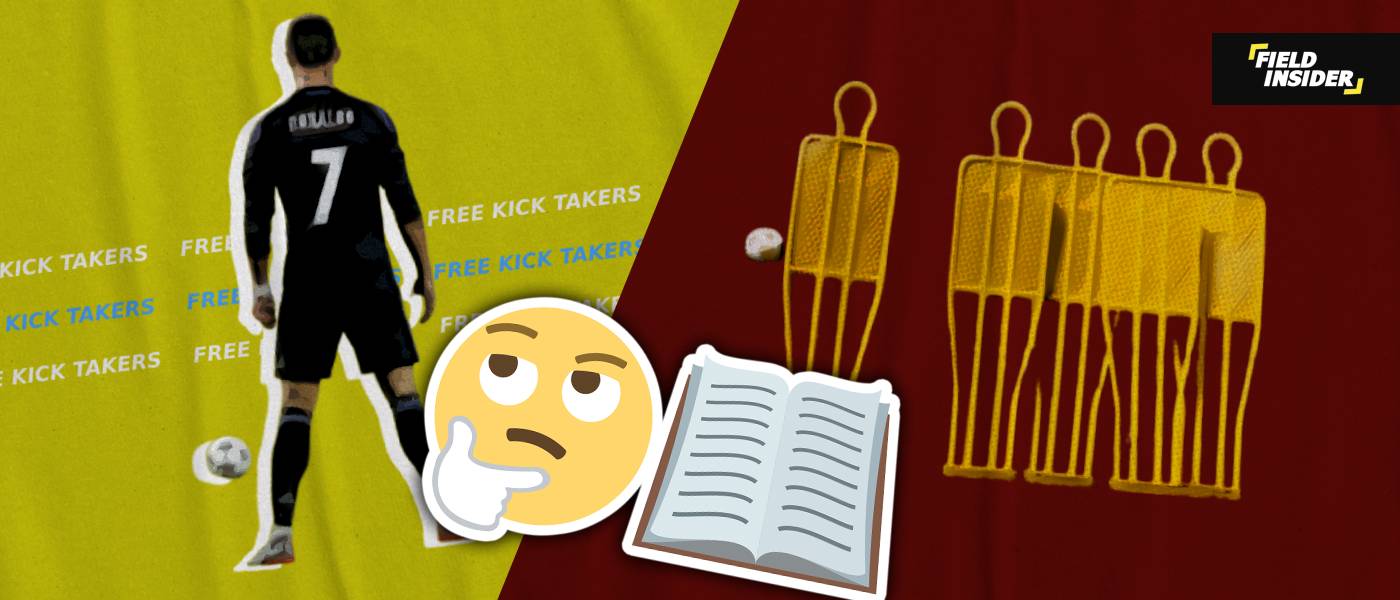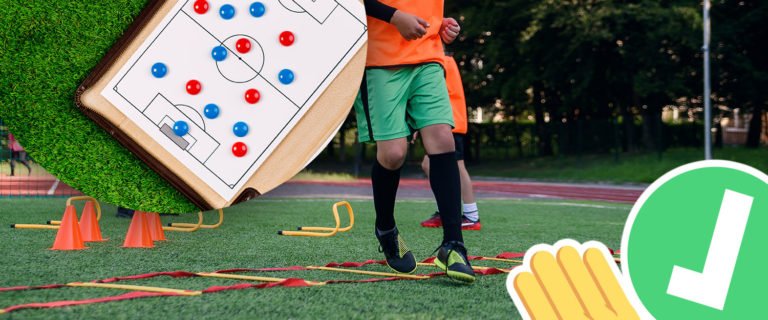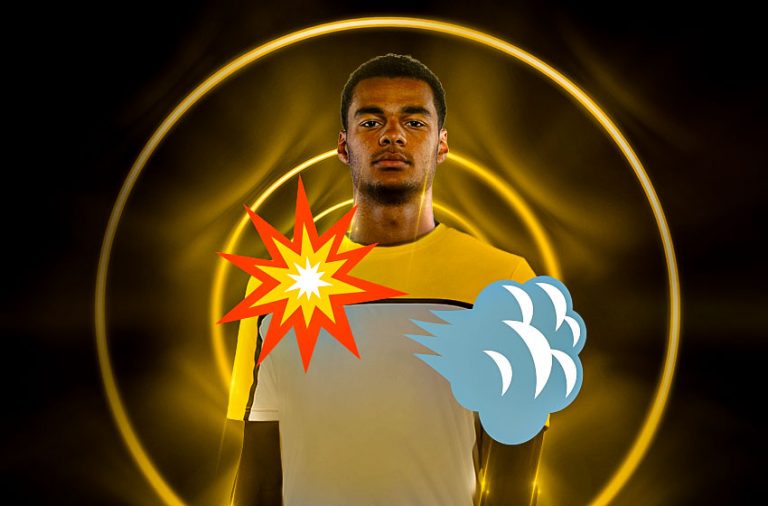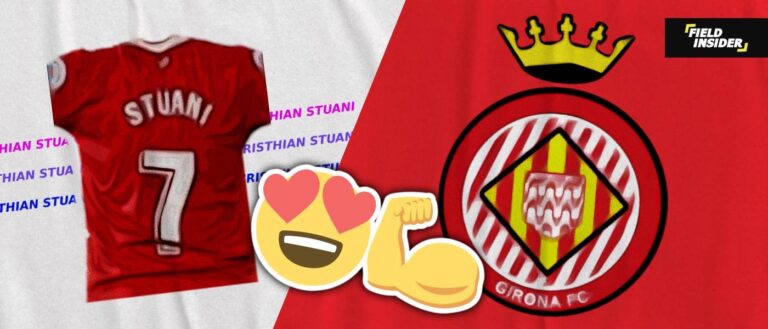What Is A Free-Kick In Football? Ultimate Guide
In the dynamic world of football, a free-kick is not just a set piece; it’s an art, a moment of high drama, and often, a game-changer. A free-kick is a method of restarting play in football, awarded after a foul or infringement.
Historically, free-kicks have resulted in some of the most iconic and memorable moments in soccer, etching the names of expert free-kick takers into the sport’s lore.
The positioning, distance from the goal, and the angle of a free-kick all play into the hands of a player’s unique approach, making each free-kick situation a unique and suspenseful scenario.
This makes the free-kick not just a restart mechanism, but a vital and exhilarating aspect of football, capable of turning the tide in crucial moments.
Key Takeaways
| Aspect | Details |
|---|---|
| Definition | A method to restart play following a foul or infringement |
| General Rules | Awarded for fouls, must be taken from the spot of the infringement and opponents must be at least 9.15 meters (10 yards) away |
| Causes | Fouls, handballs and other rule violations |
| Types | Direct (can score directly) and Indirect (requires touch by another player) |
| Positioning | Key for attackers and defenders |
| The Wall | A defensive strategy to obstruct the free-kick taker’s view and shot |
What is a Free kick?
In soccer, a free kick is a pivotal moment that arises when a team is awarded a kick due to a foul committed by the opposing side. This momentary pause in play is a crucial opportunity for the fouled team to potentially gain an advantage.
The game stays stopped and all action pauses until the referee blows the whistle to signal the free kick, ensuring both teams are ready and following the rules.
Types of Free kicks
During a free kick, the team awarded the kick faces a strategic choice. This decision often depends on the free kick’s location, the team’s playing style, and the abilities of the players on the field.

direct free kick
They can opt for a direct attempt on goal, trying to score by bypassing the wall of defenders and outsmarting the goalkeeper.
Direct Free Kick Signal
For a direct free kick, the referee blows his whistle and extends his arm horizontally. When players see this signal, they instantly understand that a direct free kick has been given.
indirect free-kick
Alternatively, the team may choose to pass the ball to a teammate first. This indirect approach can be a tactical maneuver to disrupt the defensive formation of the opposing team, create better shooting angles, or simply to retain possession in a more advantageous position on the field.
Indirect Free Kick Signal
For an indirect free kick signal, the referee blows his whistle and extends his arm vertically above his head. This signal indicates to the players that an indirect free kick has been given.
General Free Kick Rules
When a player from any team commits a foul, play stops. To restart play and take the free kick, the basic formalities remain essentially the same, regardless of the type of free kick awarded.

The Rules
Below, we will discuss the rules surrounding free kick-taking after the foul has been committed. It must be kept in mind that all free kicks follow the Law 13 of the IBAF laws of the game.
- Before restarting the play, it must be made sure that the ball is not moving, ergo it is stock-still.
- The ball enters play only after someone touches and moves it.
- The player taking the free kick is only eligible to touch the ball once.
- The team must take the free kick from the exact spot where the offense occurred. However, if the foul happens off the pitch, play restarts from the nearest spot to that area.
- If the foul is given by the umpire within the teams’ goal area, then the team is allowed to station the ball anywhere within that area.
- The teams’ players defending the free kick are only allowed to stand or form a wall ten yards away from the spot of the free kick.
Causes of Free Kick
The Mystery of Direct and Indirect Free Kicks
Whenever one team commits an offense against the opponent, the opposing team receives a free kick. The question then arises about the type of free kick awarded and the process for executing it.
The answer to that question depends on the kind of offence committed. After analyzing the offence, the referee decides which free kick should be awarded.
Causes of a direct free kick
If a player from any team commits specific types of infractions during the game, the opposing team is granted a direct free kick. These offenses include actions such as;
Use of unnecessary extra force
Most of the free kicks awarded by the referee is due to the imprudent behavior of a player. If the referee considers that a certain player has used an excessive force or recklessness while
- Pushing or jumping at an opponent player.
- A kicking or striking attempt on an opponent player.
- Unnecessarily holding onto an opponent player.
- A grave attempt of tripping or trying to trip an opponent player.
COMMITTING A HANDBALL
The goalkeeper is the only player allowed to touch the ball with their hands. If any other player commits a handball, the opposing team receives a direct free kick.
IMPRUDENT BEHAVIOR
If any player is found guilty of acting out rashly or causing distastefulness in the peaceful environment of the game, a free kick is awarded to the opponent team. Such actions include;
- Spitting at opponent
- Physical offence committed against an opponent
- Toss an object or ball at an opponent or the referee
This kind of behavior is intolerable and often results in yellow or red cards given to the player.
ENTERING THE PITCH OR INVADING THE PLAY
In any scenario, no one can enter the pitch or interfere with the play without the match official’s consent. Therefore, if a substitute or a team’s official enters the pitch without the referee’s permission, the opposing team gets awarded a free kick.
Causes of an Indirect Free Kick
An indirect free kick can be awarded for several reasons. They are less common than the direct free kicks as the offences which result in the awarding of indirect free kicks happen scarcely.
The general infractions which result in an indirect free kick awarded to the opposition are;
- If a player is caught offside, an indirect free kick is awarded. This is the most common infraction behind an indirect free kick being awarded to the opposition.
- Illegal handling of the ball by goalkeeper
- Impeding an opponent teams’ player without any physical contact.
- Dissent between a player and match official or between two or more than two players.
- A player attempts to kick the ball while the goalkeeper was releasing it.
- Tried to impede the goalkeeper while he was releasing the ball.
- Playing in a reckless way not necessarily committing any foul or infraction.
- Making offensive gestures or being abusive towards other players.
- Entering the pitch without the match referee’s consent but not interfering with the play.
- If a player tries to distract or obstruct the player in any way taking a throw-in.
Other than the above-stated infractions, there are some more due to which an indirect free kick can be awarded to the opponent team. Such infractions are related to penalty-taking, triggering the match referee to award indirect free kicks to the opponent team. Those infractions include;
- The penalty failed to go forward.
- An illegal feint was made by the player taking a penalty to distract the goalkeeper.
The Art of Taking a Free-Kick
In the realm of football, mastering the art of the free-kick is similar to a musician perfecting a symphony. It’s a skill that combines raw talent, continuous practice, and an almost scientific understanding of the game’s physics.
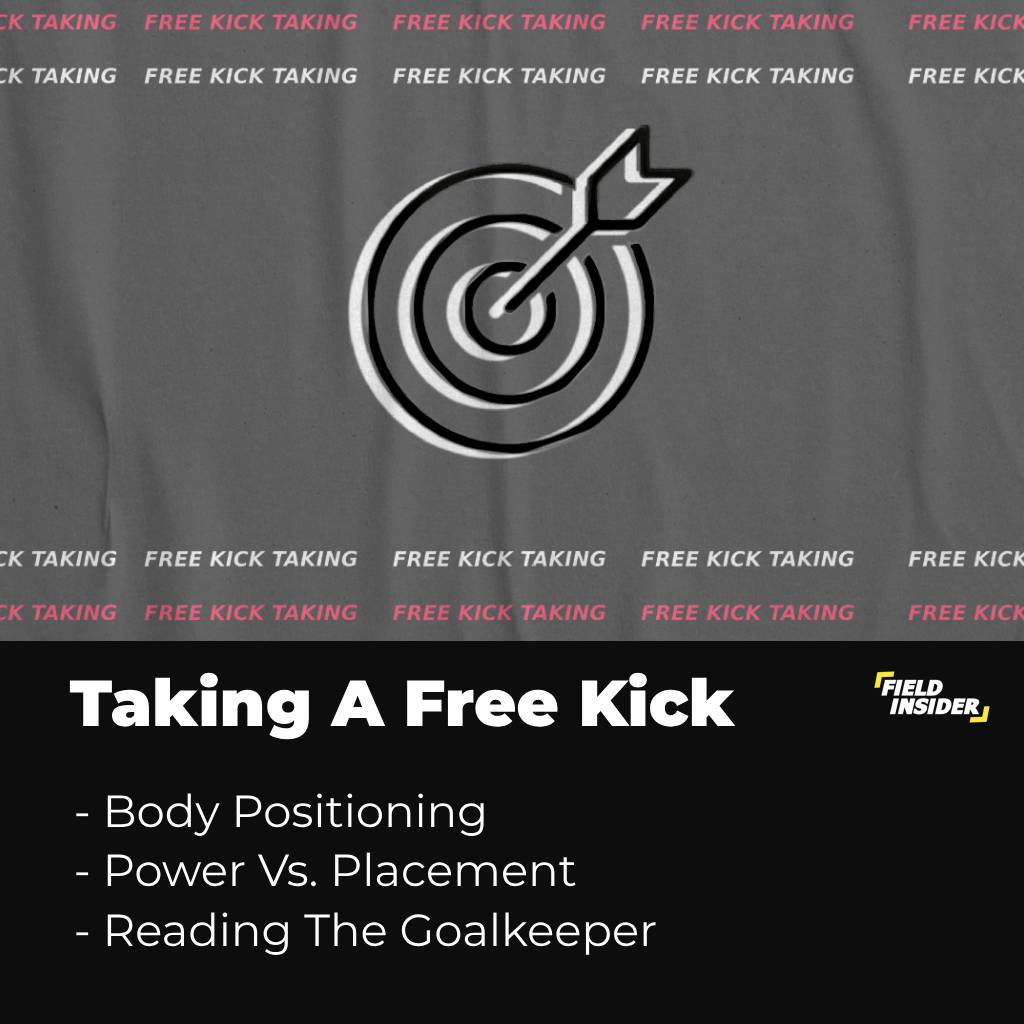
Players like Lionel Messi and David Beckham have not only mastered this skill but have also raised the bar, turning free-kick taking into a respected spectacle in soccer.
Precision and Technique
A free-kick specialist stands out not just for their ability to score but for their precision and technique. These players have an ability to read the game, anticipate the wall’s movement, and the goalkeeper’s position.
Their training is focused on sharping these skills, often spending countless hours perfecting their craft.
- Ball Placement: The first step in the free-kick ritual is placing the ball. The way the ball is set — whether it’s tilted, laid flat, or positioned at a certain angle — can significantly influence its path.
- Approach Run: The run-up to the ball is about rhythm and angle. A longer run-up can generate more power, but it’s the angle of approach that often determines the type of spin imparted on the ball.
- Body Positioning: Body posture and positioning during the strike are pivotal. The foot’s placement, the leg’s swing, and even the follow-through can drastically alter the ball’s flight path.
Striking Techniques
The way the ball is struck determines its behavior in flight.
- Swerve and Dip: This technique involves striking the ball off-center to create spin, which causes the ball to swerve in the air, often dipping sharply as it approaches the goal. It’s a method that has been famously used by players like Juninho.
- Power vs. Placement: Some free-kick takers prefer raw power, hitting the ball with sheer force to blast it past the wall and the goalkeeper. Others focus on placement, using finesse to curl the ball around the wall or into the top corner.
Psychological Warfare
A significant part of taking a free-kick is the psychological battle with the goalkeeper and the defensive wall.
The best free-kick takers are good at disguising their intentions, often waiting until the last moment to reveal the direction of their shot. This split-second uncertainty can be the difference between a save and a goal.
- Reading the Goalkeeper: Understanding the goalkeeper’s tendencies can offer an advantage. Some goalkeepers tend to take a step in the anticipated direction before the ball is struck, which can be exploited.
- Dealing with the Wall: The wall can obstruct the view and reduce the angle of the shot. Clever free-kick takers use this to their advantage, curving the ball over or around the wall, or even targeting the side of the goal the wall is guarding, banking on the goalkeeper’s delayed reaction.
The art of taking a free-kick in football is a blend of science, psychology, and raw skill. It’s a moment in the game where a single strike can turn a player into a hero, immortalizing them in the annals of football history.
How Often are Free Kicks Scored in the Premier League?
The graph below illustrates the number of free kicks scored in the Premier League for each season from 2013-14 to 2022-23. It provides a clear visual representation of how the frequency of free kicks scored has varied over the years.
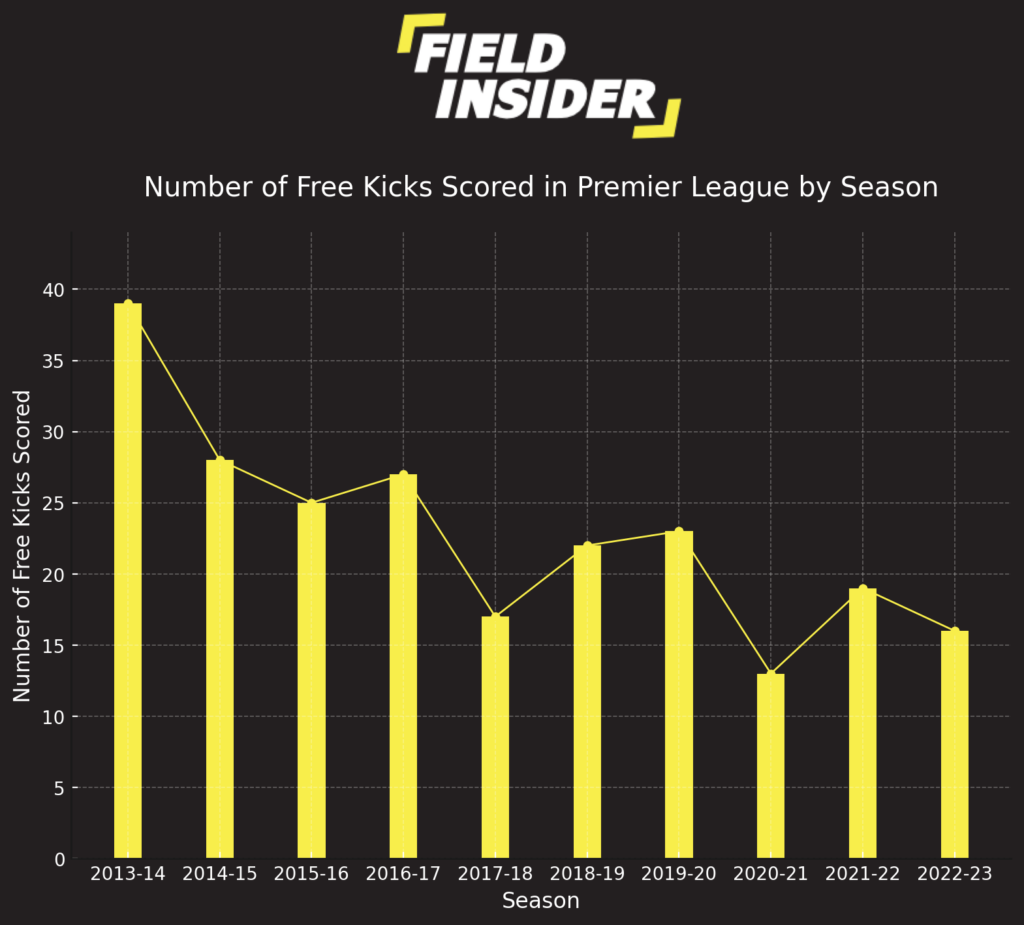
Observations from the graph include:
- Peak in 2013-14: The season of 2013-14 saw the highest number of free kicks scored, with a total of 39.
- Downward Trend: There appears to be a general downward trend in the number of free kicks scored, particularly noticeable from the 2017-18 season onwards.
- Recent Seasons: The lowest number was recorded in the 2020-21 season with only 13 free kicks scored. There has been a slight increase in the two subsequent seasons, but the numbers remain relatively low compared to earlier seasons.
Defensive Tactics Against Free-Kicks
Defending against free kicks is as strategic as taking them. The formation of the wall and its positioning is a science in itself. Defenders must anticipate and adapt to block or deflect the kick, while goalkeepers play a pivotal role, making game-saving decisions and actions.
Forming the Wall
The wall is a critical element in defending against free-kicks. Defenders line up to form a barrier, aimed at reducing the angles available for the free-kick taker.
The positioning of the wall is a tactical decision, often influenced by the distance of the free-kick from the goal and the kicking style of the opponent. A well-organized wall can significantly diminish the chances of the ball finding its way into the net.
Goalkeeper’s Role
The goalkeeper’s role in a free-kick scenario is multifaceted. They need to correctly judge the ball’s path, which often involves anticipating the free-kick taker’s technique, be it power, swerve, or placement.
Goalkeepers also direct the formation of the wall, ensuring it covers the most vulnerable part of the goal, while they position themselves to cover the rest.
Training and Preparation
Teams invest considerable time in set-piece training to enhance their defensive capabilities against free-kicks. This includes practicing various wall formations, goalkeeper drills, and simulated free-kick scenarios to prepare for actual game situations.
Notable Free-Kick takers in Football History
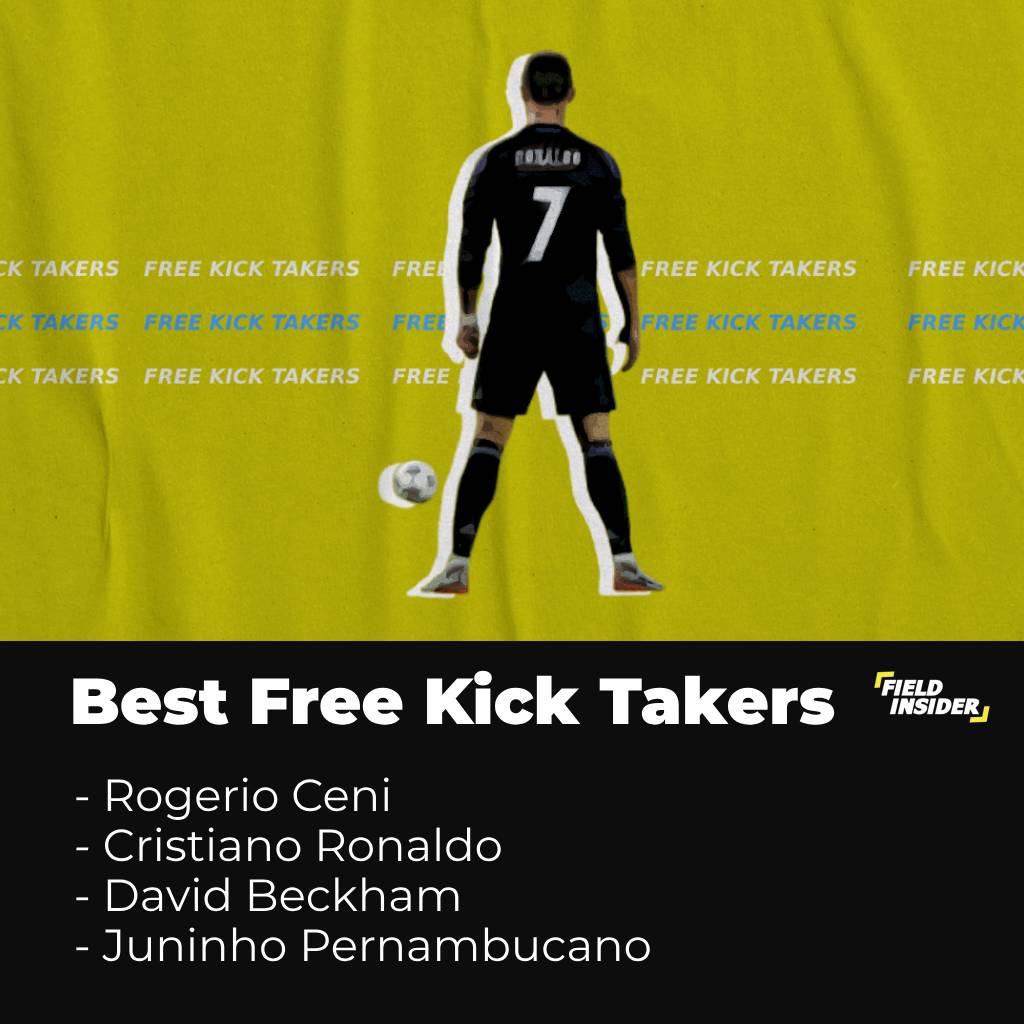
This table encapsulates the prowess and achievement of some of the most iconic free kick takers in the history of football. Each player brought a unique style and skill set to the game, leaving an indelible mark in football .
Top Free-Kick Scorers in Soccer History
| Rank | Player Name | Free Kick Goals | Notable Information |
|---|---|---|---|
| =10 | Rogerio Ceni | 59 | A goalkeeper with an extraordinary scoring record from free-kicks. |
| =10 | Marcelinho Carica | 59 | Renowned in Brazil, played for top clubs like Flamengo and Corinthians. |
| =10 | Ronald Koeman | 59 | Impressive tally for a defender; over a quarter of his career goals from free-kicks. |
| 9 | Cristiano Ronaldo | 61 | One of two active players on this list; potential to rise in ranks |
| =7 | Diego Maradona | 62 | Known for his versatility and skill; a free-kick specialist. |
| =7 | Zico | 62 | Fifth highest goal scorer in Brazil’s history; an outstanding career. |
| =5 | Lionel Messi | 65 | Currently fifth; a strong contender for a higher spot in the future. |
| =5 | David Beckham | 65 | The most prolific free-kick scorer from Europe in football history. |
| =3 | Ronaldinho | 66 | Famous for his 2002 World Cup free-kick against England. |
| =3 | Victor Legrottaglie | 66 | Spent entire career in Argentina; never played for the national team. |
| 2 | Pele | 70 | A testament to his all-around skill and ability in the game. |
| 1 | Juninho Pernambucano | 77 | Holds the title of the free-kick GOAT (greatest of all-time). |
Common Misconceptions About Free Kicks
Many myths surround free-kicks. This section aims to clarify these misconceptions, particularly regarding rules and strategies, enhancing understanding and appreciation of the game.
1. Direct and Indirect Free Kicks Are the Same
One common misunderstanding is that all free-kicks offer a direct route to score. In reality, only direct free kicks allow a player to score directly without the ball touching another player.
In contrast, indirect free kicks require the ball to be played by another player before a goal can be scored. This distinction is crucial in understanding and anticipating the potential outcomes of a free-kick scenario.
2. The Wall is Just About Numbers
Many believe that the more players in the wall, the better the defense. However, the strategic placement of the wall, considering the kicker’s tendencies and the goal’s vulnerable areas, is more important than the number of players.
A well-organized wall with fewer players can be more effective than a larger, poorly positioned one.
3. The Goalkeeper’s Role is Passive
It’s a common belief that goalkeepers play a passive role during free-kicks, relying solely on the wall. However, goalkeepers must actively analyze the situation, position themselves effectively, and be ready to make split-second decisions and saves. Their role is as dynamic and crucial as any outfield player.
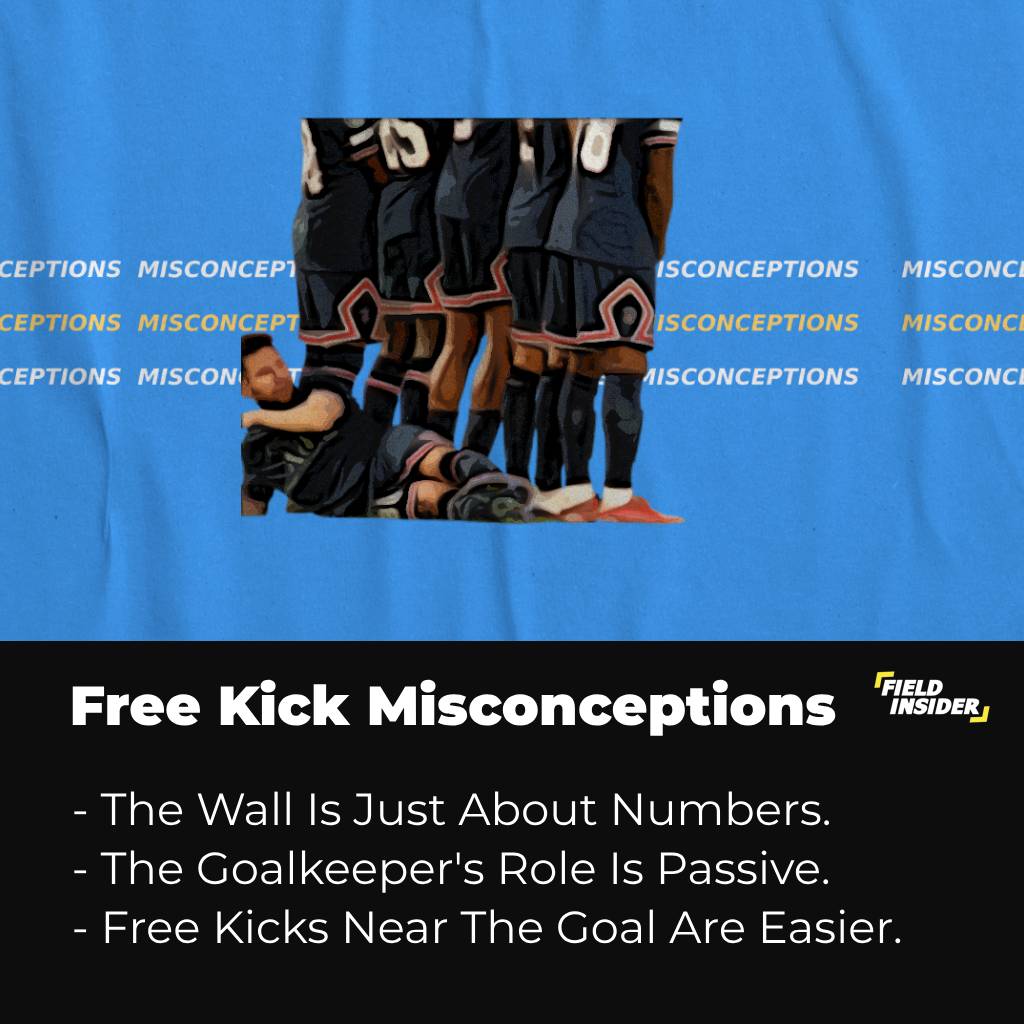
4. Free Kicks Near the Goal Are Easier
While it might seem that free-kicks closer to the goal offer an easier scoring opportunity, they often leave less room for the ball to maneuver over and around the wall. Skilled free-kick takers must therefore employ techniques like dipping or curving the ball to navigate these tight spaces.
5. Any Player Can Take a Free Kick
While technically any player can take a free-kick, the skill required to execute an effective one is significant. It involves understanding ball physics, mastering various striking techniques, and having the mental composure to handle high-pressure situations.
Conclusion
Free-kicks in soccer are a complex blend of rules, strategies, and skills. By dispelling common myths and clarifying misconceptions, we can deepen our understanding and appreciation of this vital element of the game.
This intricate piece of football’s tapestry is more than just a set-piece; it’s a moment where strategy, skill, and anticipation converge to create some of the most memorable moments in the sport’s history.
Whether a casual fan or a seasoned player, recognizing the nuances of free-kicks adds a richer dimension to the football experience.


